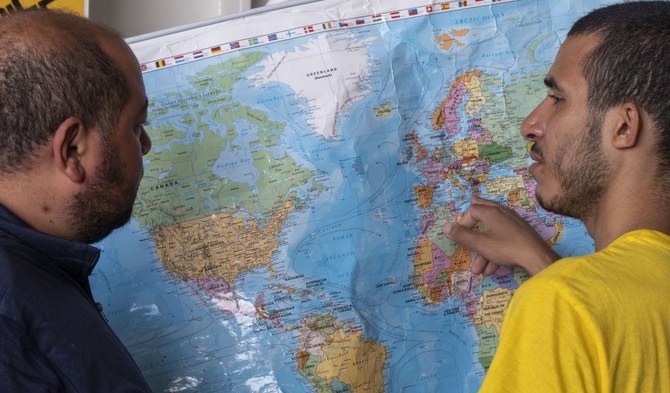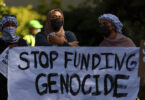Nadim Shehadi
Fairuz, the iconic Lebanese singer, puts on the melancholic tone of a lovesick girl with a dilemma who longingly appeals to her absent lover to “Come and Don’t Come.” She asks him to lie to her and say that he is coming: “A lie is not a sin, promise that you will come and come but don’t come.” Europe has a similar predicament with immigration.
Europe’s problem is that it badly needs immigrants but at the same time it is doing everything it can to prevent them from coming and, when they do arrive, it has difficulties integrating them into society. Politically, the resurgence of far-right parties and the difficulties in integrating immigrants and refugees is a toxic combination. Yet the dual problems of an aging population and an imbalance in the distribution of skills means that Europe needs to find a way to accommodate young newcomers and train them to fill both gaps.
In Western Europe in particular, aging populations mean that social security systems are threatened with collapse if there is no injection of young people who will contribute to future retirement pensions. The math is simple: we have always been under the illusion that our social security contribution is an investment in our own future, like putting money in a piggy bank. In reality, today’s contributions are financing other people’s current pensions. What pensioners long ago thought of as investing in their own future is paid for by the contributions of younger people today. An aging population means less money available for more people. The piggy bank has a gaping hole in the bottom that keeps growing, while it is being filled less and less. Europe is also moving politically to the right as it gets older. When the young people of today reach the age of retirement, their pensions need to be paid for by the young people of tomorrow, but there will not be enough of them if their numbers are not boosted by immigration. People are living longer and, the longer they live, the more they will depend on pension funds – immigration is their lifeline and they are against it at the same time.
But this is not all. For Europe to become competitive, especially with the rise of China, it needs to regain a set of skills it has lost over time. It has invested in higher and less practical academic qualifications and lost the more practical ones. The result is that there are more engineers than there are mechanics. In the health sector, what is needed is more nurses and people to operate machines and maintain them; there is no shortage of doctors. You may have the chefs, but you also need the sophisticated maitre d’ with languages, as well as waiters, dish washers and potato peelers. Europe has invested in high-end academics and neglected vocational skills, meaning these need to be filled by immigration. In other words, the European workforce needs to import or train a broad range of skills that it has lost through its educational policies.
Tim Cook, the CEO of Apple, says that the popular conception that companies go to China because of low labor costs is wrong. “China stopped being the low-labor-cost country many years ago. And that is not the reason to come to China from a supply point of view. The reason is because of the skill, and the quantity of skill in one location and the type of skill it is,” he said. Cook gives the Chinese educational system the credit for maintaining vocational expertise while other countries were de-emphasizing such skills.
He used the example of the tooling skills required to manufacture Apple products. “In the US, you could have a meeting of tooling engineers and I’m not sure we could fill the room. In China, you could fill multiple football fields,” he said. For a society to function, you need plumbers, mechanics and people who can do maintenance – in other words, the full spectrum of skills. These are the ones that European nations need to import, but they are only getting the mass labor that is not trained. Europe needs to invest in vocational training, especially of the newcomers, the immigrants and the refugees. You need to train the practical people to fill the gaps.
At the same time, immigration is a complex and controversial issue in Europe, as it involves economic, social, cultural and security aspects. You hear of social unrest, border disputes and threats to leave the EU, with walls and border fences being erected. Migrants and refugees are often perceived as a security threat and a source of social unrest in countries like France, Sweden, the Netherlands and Belgium. The attempts to stop them are also a humanitarian crisis involving human rights violations. The International Organization of Migration estimates that more than 26,000 people have died or gone missing in the Mediterranean since 2014. Human rights organizations report that migrants are exploited, abused and subjected to violence and trafficking.
The bottom line is that Europe needs to find the right formula to integrate the migrants and, at the same time, avoid political problems like the rise of populism and the far right. It also needs to import or create the skills that are needed for it to restore a productive economy. It is a multidimensional balancing act. The choice is between two very different models of integration: the French and the British and their variants. The French approach is that of full assimilation. They believe they can turn new arrivals into Frenchmen and women and the emphasis is on republican values, such as universalism and secularism, leading to integration.
British multiculturalism has no such ambition. It recognizes and celebrates cultural and religious diversity and encourages the coexistence of various groups, which are given some autonomy and freedom in terms of religious and cultural practices. The same words have opposite meanings in each model. Pluralism in the British model means that different communities can live together while preserving their own identities, while “pluralisme” in France means that different people can be integrated into one French culture and one identity.
Even if a happy medium is found and Europe manages a better integration, there is still a far more complicated problem of whether to treat the problems at source or to wait until they come to you. There was a time when intervention was justified in the countries that the migrants and refugees were fleeing from, and this was reflected in EU policies. Aid can be channeled to vocational training in the countries that are the source of migrants; it does not need to be done now, it should have been done 10 years ago. Ideally, Europe should be able to choose, like the Canadians do, based on certain criteria and needs. Attempts to make deals with countries like Tunisia, Libya and Turkiye to control the migration flow have had limited results and the methods remain controversial.
Looking at Europe from the East, the picture is different. The numbers of refugees and immigrants are relatively small compared to those absorbed by countries like Turkiye, Jordan, Lebanon and some Gulf states. The net inflow to Europe in 2021 was 1.2 million people in a population of close to 450 million, just over 5 percent of whom are migrants and refugees. It is not a case of exaggerating a problem, it is also a case of messing up the solution.
No wonder The Financial Times last month described European policy on refugees as being in “disarray,” with little room for rational debate. A friend summarized it well by saying that Europe is all icing and no cake. What it is importing is a base, but to have the whole cake – i.e., the right combination of knowledge and skills – it needs to find a way of discussing immigration rationally rather than emotionally.







